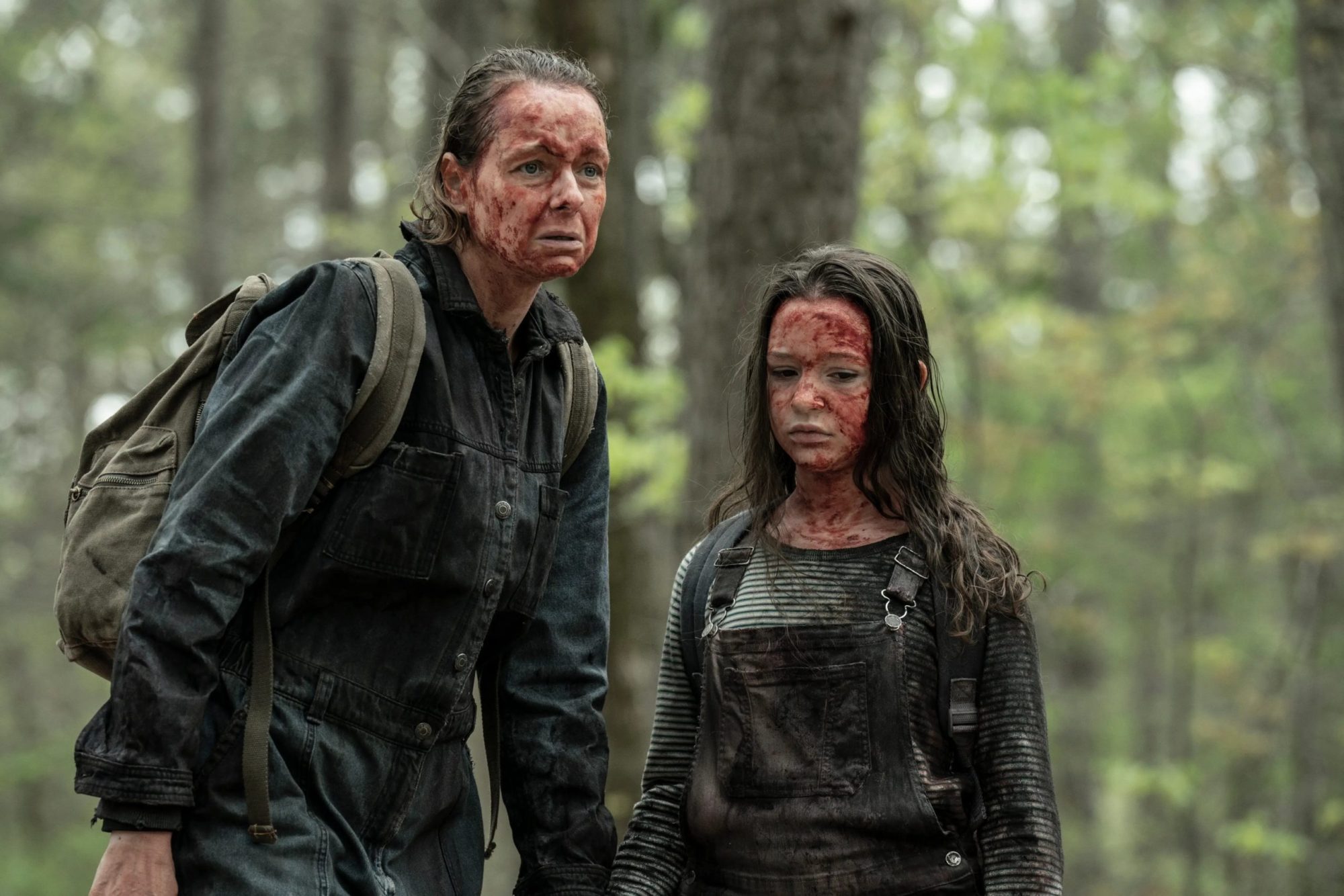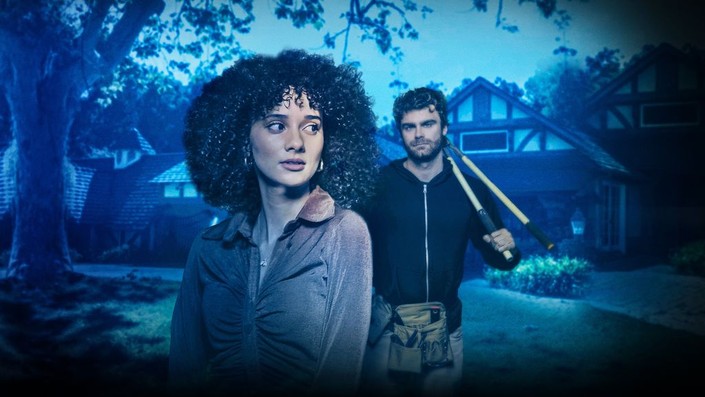Reviews
“Tales of the Walking Dead” Review – Alpha Origin Episode Shows Full Potential of New Spinoff Series

With the latest episode of “Tales of the Walking Dead,” the fresh spin-off has veered as close as it has to the original world and characters of the flagship series. Simply titled “Dee,” the episode follows none other than Season 10 villain Alpha, once again brought to terrifying life by Samantha Morton. While Season 10 brought us a glimpse at who Alpha was before she became leader of the Whisperer clan, this installment of “Tales” shows us an earlier event from Alpha’s past.
Taking a concept that very well could’ve served as the basis for a separate episode featuring new characters, “Dee” mashes an original zombie survival tale with an already well-known character from “The Walking Dead” universe. This enables the episode to not only provide a compelling deep dive into a fan-favorite, but also depict a refreshing zombie apocalypse experience that we haven’t yet seen in the main series before. There’s a few questionable and slightly confusing narrative turns within the episode, but luckily they don’t detract much from what is really a vehicle to showcase Samantha Morton’s exceptional performance.
We find Dee living with her daughter Lydia (Scarlett Blum), who remains a surviving character as a teenager in the current seasons, on a large boat that is floating through an eerie swamp. The lives of the passengers are overtly lavish and filled with faux motivational workout classes all spearheaded by optimistic boat leader Brooke (Lauren Glazier). The refreshing world within the ship contrasts greatly with the atmospheric, almost gothic horror atmosphere of the surrounding swamps. Walkers shamble between trees in the distance and low fog clings to the murky water. The passengers have come together to form a bubble of sorts, living on the ship as if the outside world remains as it was.
Losing the trust of her daughter and acceptance of those around her, Morton’s Dee becomes increasingly agitated with how things are running on the ship. Long story short, chaos does ensue simply between the human characters (as the flagship show has warned us of so well), leaving Dee to flex her bloodthirsty survival skills in what serves as an eerie precursor of what is to come down the line. The wild, sea-born tale is occasionally interjected by an ominous apocalypse-worn Alpha (seen with her iconic bald head) standing within a severed head-covered cave. Throughout the episode audiences aren’t keyed into who exactly she is retelling this story too, but in the final moments their questions are answered with typical “Walking Dead” macabre flare.
Morton’s depiction of Dee is one of the main reasons why this episode works so well. It’s a performance that has since continued to stand out even when considering the earlier seasons of the flagship series. Her stone-cold demeanor, daggered eyes, and precise dialect infuse a chilling ambience to all of Dee’s scenes. What makes the episode so enjoyable for longtime fans of the show, is that each scene feels ten times more intense simply considering the ticking time bomb of Dee’s transformation into Alpha. Audiences know exactly what Dee is capable of, making all of her intense choices even more of an exciting experience for avid fans.
“Dee” also happens to have the best walker gag of the spin-off series thus far in which Dee learns the cover-yourself-in-zombie guts trick. Scrambling to hide after being knocked off balance during a walker attack, Dee buries herself underneath a particularly skeletal walker’s corpse. Within seconds the torso of the decaying creature snaps open, swallowing Dees face into its mutilated ribcage. Drenched in the rotten blood of the undead, Dee coaxes young Lydia to crawl into the zombie torso with her in an absolutely twisted scene of mother-daughter survival.
Much like the “Here’s Negan” bonus episode, “The Walking Dead” franchise shows great strength and effectiveness when it focuses on its most compelling characters in contained, character-exploration pieces. Much of the original’s current shortcomings come from the overabundance of storylines and characters. Perhaps “Tales of the Walking Dead” as a whole would’ve worked better as an episodic revisit of past-characters at different points in their apocalypse journey.

Movies
Lifetime’s ‘Fatal Fixer Upper’ Needs a Few Plot Repairs [Review]

Writer Adam Rockoff reteams with director David DeCoteau on a new Lifetime thriller that bears a striking resemblance to this month’s earlier title, Million Dollar Lethal Listing.
In Fatal Fixer Upper, Vivian (Jasmine Aivaliotis) and Ryan (Philip McElroy) are a young married couple preparing to purchase their dream home. Just like in Million Dollar Lethal Listing, the deal is too good to be true: the house is wildly underpriced, the owner is looking for a quick sale, and they’re asked to make a hefty cash deposit.
Unlike the former title, though, there’s no mystery about who the villain is in Fatal Fixer Upper. The film opens with a classic Lifetime cold open that immediately establishes that there is a bad man keeping an eye on things. His identity is quickly revealed as Josh Thomas (Duke Van Patten), the home’s original owner and the person spying on Vivian when she checks out the property with her father, Roger Fields (an underused Dorian Gregory).
Alas there’s no room for subtlety in Van Patten’s performance as he immediately goes from spying on Vivian to snapping at realtor Sandy (Eliza Roberts) and neighbour Jill (Grisselle Escotto). Considering how easily he flies off the handle, it’s a surprise that Josh stays calm long enough to ingratiate himself into Vivian and Ryan’s lives by doing repairs around the house.

Because Josh is revealed as the villain early on, Fatal Fixer Upper is an exercise in patience. The audience is always one to two steps ahead of Vivian and Ryan, which requires the screenplay, co-written with Jeffrey Schenck and Peter Sullivan, to find entertaining ways to fill the time until the characters catch up in the last act.
Unfortunately the film relies too heavily on clichéd characters and formulaic developments. Naturally there’s a concerned therapist, Dr. Shaw (Diane Robin), who questions if Josh is taking his meds. There’s also Ryan’s cousin, Casey (Randy Jay Burrell), a police officer-turned-PI who investigates Josh after the homeowner explodes at a BBQ in front of everyone. And you know that Sandy’s in danger the moment she confirms to Vivian that Josh lied about where he’s living (sidebar: the film treats this as a reveal, but anyone who has ever seen a horror film will immediately call it).
The fact that danger and injury befalls anyone who questions or gets in Josh’s way is inevitable, though the way DeCoteau shoots action leaves something to be desired. Characters tend to die easily in Lifetime films, and Fatal Fixer Upper is no different: one person is briefly strangled before they’re dragged off screen and another is struck in the back of the head. Considering a third act hit and run looks far worse, but the victim barely uses crutches a day later, the impact of violence in the film feels wildly inconsistent.

Another Lifetime trait is the presence of ineffectual police officers. Here the role is played by Detective Jones (Rachel Wong) who does believes the couple about Josh’s increasingly unhinged behaviour, but doesn’t assign a police guard outside their home until after dark (perhaps she believes Josh is a vampire?).
While Fatal Fixer Upper rarely surprises, there are a few notable moments of inspiration. Like Million Dollar Lethal Listing before it, this Lifetime film’s secret strength is interrogating the integrity of the central couple’s marriage. As the film progresses, it’s revealed that Vivian and Ryan aren’t as solid as they initially appeared to be, and their doubts about the other help to sustain the film until its violent climax.
In terms of performances, Aivaliotis is a sympathetic lead with a decent amount of agency. It’s nice that she refuses to take crap from Ryan when he questions her about Josh’s continued presence around the house. McElroy is likewise solid as the suspicious husband, though Ryan makes some questionable decisions in the finale that seem more motivated by plot than by character.
That leaves Van Patten, who has arguably the trickiest role. He’s best when Josh is awkwardly trying to flirt with Vivian, even going so far as to initiate a rom-com moment when he’s sprayed by water and has to change shirts in front of her. Unfortunately when Josh loses his cool, Van Patten always plays him at a 10, so there’s no range or escalation. The performance needed to be dialed back to give it levels.
Fatal Fixer Upper‘s other fatal quality is that there are simply too many characters. Jill and her husband exist solely to offer vague exposition at convenient moments, but because they’re new parents, they’re equipped with plot armour.
Then there’s Josh’s ex-wife, Michelle (Savoy Bailey), who only returns after the cold open to diagnose Josh with a ridiculously laughable (and highly fabricated) disease that “explains” his behaviour. Fatal Fixer Upper has its share of deaths, but there are a few too many red shirts wandering around by the time the credits roll whose deaths might have helped to make the film more memorable.
Overall, this is pretty standard Lifetime fare. Fans of DeCoteau and Rockoff’s previous collaborations will undoubtedly appreciate it, but for the uninitiated, Fatal Fixer Upper is solidly mid-tier.
Fatal Fixer Upper premieres on Lifetime Thursday, April 25 at 8/7c.


















You must be logged in to post a comment.